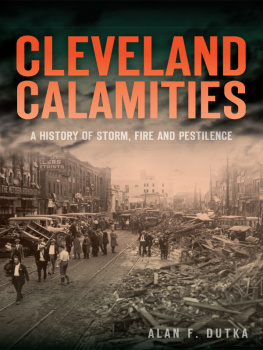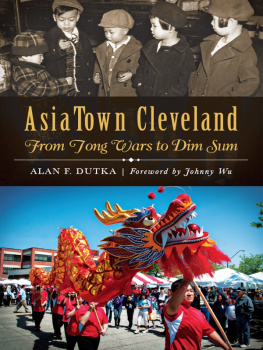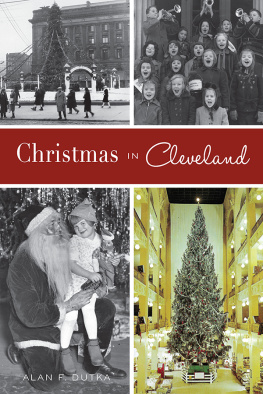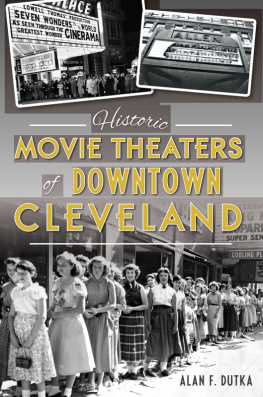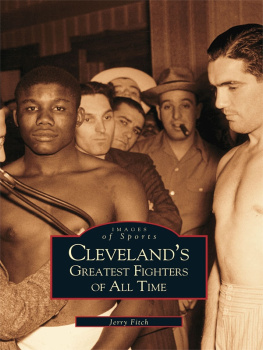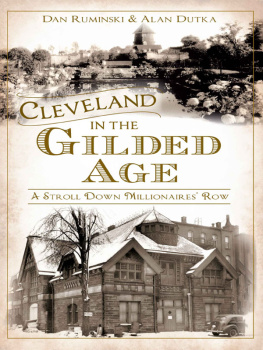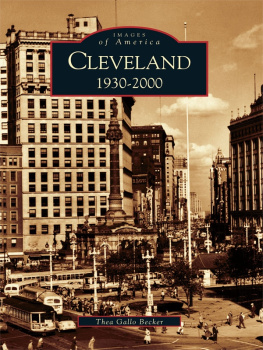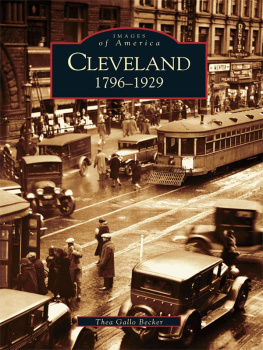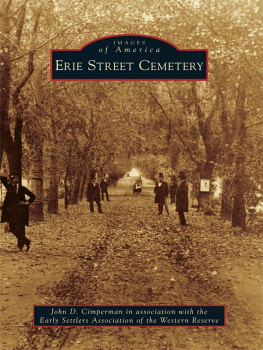

Published by The History Press
Charleston, SC 29403
www.historypress.net
Copyright 2014 by Alan F. Dutka
All rights reserved
First published 2014
e-book edition 2014
ISBN 978.1.62584.828.4
Library of Congress CIP data applied for.
print edition ISBN 978.1.62619.336.9
Notice: The information in this book is true and complete to the best of our knowledge. It is offered without guarantee on the part of the author or The History Press. The author and The History Press disclaim all liability in connection with the use of this book.
All rights reserved. No part of this book may be reproduced or transmitted in any form whatsoever without prior written permission from the publisher except in the case of brief quotations embodied in critical articles and reviews.
CONTENTS
PREFACE
One of my earliest memories of downtown Cleveland is the crunching sound created when I stepped on thousands of insects covering the citys sidewalks. On another childhood adventure, I accompanied my parents to the Yorktown Theater, where I experienced a large pop in my ears as the theaters doors blew open, heralding a storm described as the devil wind. As an adult, after staging a Fourth of July cookout in 1969, an army of relatives returned to spend the night, unable to drive through a violent derecho.
On January 28, 1977, not listening to the morning news or weather forecasts, I drove to work accompanied by what I considered to be a fairly strong wind. Upon my arrival, a security guard informed me that the entire city had shut down and that I had just driven through the worst blizzard of the century. Nine years later, I thought I felt the earth move while driving through University Circle. Sure enough, Cleveland had experienced an earthquake centered in northeast Ohio.
The events helping to create these memories are described in this book, along with additional tales of floods, pseudotidal waves, a burning river, polio epidemics, environmental disasters, UFO sightings, a comet supposedly on target to poison the world, global cooling and a summer highlighted by a June blizzard. I hope that these stories, in addition to entertaining you, will enhance a few of your own memories.
ACKNOWLEDGEMENTS
The following individuals provided significant contributions to this book:
CLEVELAND PUBLIC LIBRARY
Beverly Austin (history)
Margaret Baughman (photographs)
Ronald Burdick (history)
Nicholas Durda (photographs)
Patrice Hamiter (photographs)
Sabrina Rosario (history)
Chris Wood (history)
CLEVELAND STATE UNIVERSITY
William C. Barrow (Special Collections)
William Becker (Archives)
Lynn M. Duchez Bycko (Special Collections)
GREAT LAKES BREWERY
Pat Conway
Marissa DeSantis
HEIDELBERG COLLEGE
Dr. Kenneth Krieger
THE HISTORY PRESS
Greg Dumais
Ryan Finn
Savannah Brennan
Natasha Walsh
Katie Parry
INDIVIDUALS
Alex Bevan
Diane Dutka
Priscilla Dutka
David Kubic
Ann Toth
Danielle Toth
Part I
WIND, RAIN, FUNNELS AND QUAKES
EXTRAORDINARY BLIZZARDS
Clevelanders seem to be burdened with more than their fair share of heavy snow and strong winds, the two building blocks of blizzards. Nevertheless, prolonged wind exceeding thirty-five miles per hour combined with visibility of less than a quarter mile, an official definition of a blizzard, really isnt very common. And many of Clevelands most notable blizzards have merely passed through the city on journeys engulfing significant portions of the United States. Yet blizzards have inspired tales of death, destruction, courage and valor that are entrenched in Clevelands history.
On January 21, 1910, heavy snow and wind ignited a two-day blizzard that created havoc across the city. In the West Park neighborhood, freight train brakeman John W. Krantz fell from the ice-covered roof of a boxcar. Landing between two moving cars, the trains wheels crushed his body. In another incident, a set of freight cars jumped a snow-covered track, plunging down an embankment. The accident decapitated the conductor. At the intersection of East Fifty-fifth Street and Broadway Avenue, snow halted a Cleveland Railway funeral car destined for Calvary Cemetery. After crewmen worked unsuccessfully for an hour attempting to free the car, the funeral party completed its journey by transferring to several carriages supplied by a nearby funeral home.
The storm also provided a setting for quick thinking and consummate courage. Eleven-year-old Ben Eisenberg, selling newspapers on Public Square, spotted a runaway horse and carriage headed directly for a throng of terrified bystanders. As the horse passed, Ben leaped onto the wagon, bringing the carriage under control just before it reached the frightened crowd. Although the fourth grader worked four hours each evening selling newspapers, he had no intention of quitting school. Ben remarked, A fellow cant do much unless he knows something.

Following a 1910 blizzard, Clevelanders helped shovel a sidewalk and road near East Ninth Street and Superior Avenue. Courtesy of Cleveland Public Library, Photograph Collection.
Just a few weeks later, a remarkable blizzard started near the Pacific Coast. The storm moved relentlessly eastward for more than a week, passing through Cleveland on its way to Buffalo. Snow, beginning in Cleveland late on February 16, continued for two days. Forty-mile-per-hour winds formed ten-foot snowdrifts; dozens of barns, livery stables and other structures collapsed under the weight of the snow.
Snowdrifts in rural areas halted interurban traffic. Beached passengers received bread, butter and nuts but could not be quickly rescued because of the deep snow. A passing interurban killed a Lakewood woman on her way to church when she mistook the trains path for a sidewalk. On March 24, less than six weeks after the second Cleveland blizzard that season, straw hat and ice cream social weather returned as the temperature climbed to eighty-seven degrees.
Three weeks into 1913, Cleveland endured a snowstorm mixed with forty-eight-mile-per-hour winds. Two months later, blinding snow, a piercing forty-mile-per-hour wind and ten-degree temperatures plunged the city into another blizzard. The storm hampered railroad employee Tony Corina from hearing or seeing an approaching slow-moving train. After hitting Corina, the conductor applied the trains brakes, pinning the workman under the wheels of the then-stopped train. These two furious storms later seemed almost inconsequential when compared with the great fall blizzard that year.

Sandwiched between the blizzards of 1910 and 1913, two snowstorms battered Cleveland in 1911. Horses pulled snowplows to remove accumulated snow from Public Square. Courtesy of Cleveland Public Library, Photograph Collection.
During the tempest of November 1913, the Plain Dealer portrayed the city as follows: Cleveland lay in white and mighty solitude, mute and deaf to the outside world, a city of lonesome snowiness, storm-swept from end to end. Helen Keller, a guest at the Statler Hotel, described her experience in these words: The rooms, the corridors, everywhere within this building, vibrates with the power of the storm outside. She further characterized the blizzard by saying, I felt the wreckage of wires. I heard the city become still, like a crying baby suddenly hushed to sleep under the thick blanket of the crib. I heard traffic stop, the hum of businesses cease, mens shouts die away.
Next page
